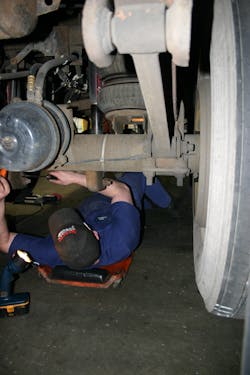Want higher equipment reliability?
At all times, management should have a clear concept of the different risks that its organization or its workers face when something does not work well or fails. When it comes to the vehicle maintenance operation, risks are threats to the whole performance of an organization.
Unfortunately, this information is not always shared with everybody within the organization. To achieve a risk-based maintenance (RBM) environment, that needs to change.
RBM involves maintenance planning and decision making to reduce the probability of failure of equipment and the consequences of those failures.
There are two main areas of focus within an RBM environment:
- The vulnerability of the operation in case of an equipment failure.
- The probability of failure caused by low reliability.
VULNERABILITY
A first step in RBM is to analyze the current processes at each step within the maintenance operation and look for history of performance from the past. The objective here is to determine what operations could be at risk if something fails. Then, measures can be taken to focus on reducing the vulnerability of the processes.
This becomes possible when the information of failure instances has been well documented. RBM requires the total accuracy of that information in order to effectively quantify the risk.
The levels of risk to persons, processes, products, equipment and the organization as a whole can and should be treated and measured.
RELIABILITY
When concentrating on reliability, the focus should be on ways to increase the reliability of the equipment, fleet or parts in order to reduce any probability of failure. Ascertain what provisions can be taken to lessen or remove those probabilities.
These determinations need to be made, not only by the people responsible for the maintenance operation itself, but also by the direct equipment users/operators and by any other associates or even customers.
Consider answers from everyone – people at all levels of responsibility inside or outside the organization. Utilize documentation and consider benchmarks and networking with other similar or different companies and even with the competition.
Include people who in the past would never have been asked or listened to, as they could turn into valuable resources. Often, when an accident or equipment failure happens, there is someone somewhere who “knew” it was going to happen. Take timely advantage of that knowledge which has traditionally been ignored.
NEW THINKING
Only companies whose management teams embrace new thinking can really aspire to achieve an effective risk-based maintenance environment.
The more an organization can implement this “new” listening, the stronger and better the quantity and quality of information and ideas contributed by people who in the past did not have a voice or any incentive to share their knowledge.
It is quite common among maintenance teams to believe – mistakenly – that they know best. Therefore, there is no benefit to listening to others.
In reality, every opinion and idea should be considered. In many cases, the ideas and suggestions from someone with no background or experience with equipment maintenance can provide a better solution.
Consider the following paraphrased story by Larry Wilson, published in his Sales Sonics manual many years ago:
At the beginning of the industrial development of the State of New York, a big industrial park was installed in the outskirts of the City of New York. A very harsh winter brought up a problem that the park’s design engineers had overlooked. The snow depositing on top of the electric power lines turned into ice and was causing cables to break.
After a long day of inconclusive discussions, one of the engineers went outside, sat on a bench and began reflecting on the serious problem that was paralyzing the operations of the industrial park every time they had a winter storm.
A homeless and apparently buzzed man approached the engineer trying to be of help. The engineer refused and asked the man to leave him alone. The man insisted several more times and the engineer said: “If I tell you my problem, do you promise to leave me alone?”
“Yes,” replied the man.
“Well, we have the problem that during a winter storm, ice accumulates on the cables that convey power to a remote industrial park, which causes cables to break and hundreds of people have to stop working because there is no power. That is our problem.”
“Ha!” the man said. “That’s easy. Just bring some of those people close to the wires and have them blow their warm breath to melt the ice.”
The engineer pulled out his wallet and gave the man the $400 that he had with him. The next morning, a fleet of helicopters were equipped with propane burners and still today are used to melt the ice when storms cause deposits on the wires.
It is sometimes the craziest ideas that lead to solutions.
OTHER TASKS
With regard to fleet maintenance, the principle of RBM is to convey the resources to the most critical maintenance tasks – those which represent the greater risks to a fleet’s productivity. Other non-critical, but necessary, tasks that maintenance personnel are often called upon to perform – such as cleaning, painting and facility maintenance – should be left to others.
Technicians ought to be spending their time turning wrenches and not doing chores or tasks that “steal” wrench time.
HIGH-TECH OUTSOURCING
In some cases, an organization may not have a large enough volume of assets to justify investing in sophisticated maintenance equipment and services and for training on such equipment. For example, tools and equipment that help detect issues and conditions that could impact equipment reliability.
These include vibration and/or oil analysis; infrared imaging; ultrasound machines; laser alignment; dynamic balancing; predictive technologies, etc.
There are companies that will provide such services on a periodic basis so smaller organizations can take advantage of these services at a reasonable cost. These services can be hired on-call or by contract on a scheduled basis.
The bottom line is this: Everything that is done within any maintenance operation should be aligned to the goals of risk reduction and extended reliability.
Enrique Mora is the title owner of Mora Global Consultants (www.leanexpertise.com). The company provides consulting on leadership, management, maintenance and processes.
About the Author
Enrique Mora
Owner, Mora Global Consultants

